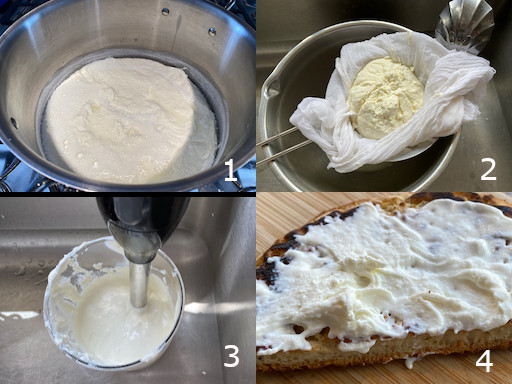It was St. Patricks day so what would be the best way to celebrate? My wife suggested that at the very least a shepherd's pie should be involved. Since St. Patricks day fell on a weekday, we made this shepherd's pie on the following weekend. I theoretically knew what shepherd’s pie was but I had never made it and I do not think I ever even tasted one. In any case, here is a Shepherd's pie made from ground lamb in small individual ramekins topped with cheddar cheese. This one really tasted lamb-y/mutton-y with nice mashed potatoes on top. So to continue, shouldn’t a traditional Irish meal include some cabbage? My contribution was a Japanese-style cabbage dish. (This is a simple home style dish my mother used to make. I realized I never posted it. Therefore, subject for future post). This Irish celebration was rounded out with the addition of a slice of Irish soda bread my wife made recently.
Ingredients: (from Washington Post, for 4 servings which made 8 small ramekins, see below #1)
1 tablespoon canola oil
1 pound ground lamb
1/2 teaspoon table salt
Freshly ground black pepper
1 medium onion, chopped (about 3/4 cup)
1 large carrot, peeled and diced (I chopped it in fairly small dice)
1 teaspoon minced thyme (I used dried thyme since we did not have fresh one)
1 tablespoon flour
1 1/2 cups low-sodium beef broth (I used chicken broth)
2 tablespoons minced flat-leaf parsley (Our parsley in the fridge was too old and we did not have dried one, so we skipped this altogether).
--The potato topping was my wife's territory---
2 russet potatoes
4 tablespoon unsalted butter
4 tablespoons onion & chive cream cheese
1 cup cheeses, grated (optional) (we used cheddar and smoked gouda).
Directions:
Position a rack in the middle of the oven and preheat to 425 degrees.
In a large skillet over medium heat, warm the oil until shimmering. Add the lamb and cook, stirring occasionally, for 5 to 7 minutes or until browned. Season with 1/4 teaspoon salt and pepper to taste. With a slotted spoon, transfer the meat to a medium bowl. Drain all but 1 tablespoon of fat from the pan. Stir in the onion and cook for 3 to 5 minutes, or until soft but not browned. Add the carrot and thyme. Cook, stirring occasionally, for 2 to 3 minutes. Add the flour and cook, stirring constantly, for 1 to 2 minutes. Gradually add the broth, increase the heat to medium-high and bring to a boil, stirring.
Return the meat to the pan, reduce the heat to medium-low and cook, uncovered, stirring occasionally, for 10 to 15, or until the lamb is cooked through and the sauce has slightly thickened. Stir in the parsley and adjust the seasonings to taste.
Meanwhile, for the potatoes: Cook in the microwave with skin on for about 10 minutes (5 minutes turn and another 5 minutes) until a screwer goes in easily. Peel and put in a bowl. Add the butter, cream cheese, salt and stir until smooth.
Using a large spoon, transfer the meat mixture to a medium casserole dish or 4 ovenproof 8-ounce ramekins (As you can see below, we used small ramekins which made total of 8 servings, #1). If there is any sauce left in the skillet, add it to the casserole or divide it among the individual ramekins. Drop spoonful of the mashed potatoes on top, then spread the potatoes across the meat mixture, forming peaks, and to the edges of the dish(es) (#2). Add the cheese (#3). Bake at 450 for 20 minutes (#4).

.jpeg)





















